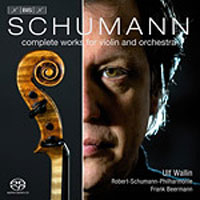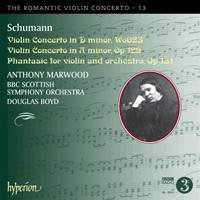Schumann • Violin Concerto in D minor; Violin Concerto in A minor; Fantasy in C major for violin and orchestra
obert Schumann’s Violin Concerto in D minor was the last work he completed, in 1853, before committing himself to the asylum at Endenich in which he died three years later. It is the most neglected of his major concert works, and probably the least known such work by any major composer. If its neglect is baffling, its history is well in keeping with the Romantic literature of its time -- which is to say, downright bizarre, involving posthumous visitations from the composer, his associates, and his artistic forebears. Schumann composed the Concerto for the amazing young virtuoso Joseph Joachim (1831-1907), who was only 22 at the time but already recognized as one of the major musical figures of his time: protégé of Mendelssohn, close friend of Brahms, a composer in his own right as well as a violinist and conductor, and eventually a pedagogue to whom such figures as the very young Arthur Rubinstein and Jascha Heifetz were brought for evaluation and encouragement. There have been some powerfully persuasive recordings of the work in recent years, by such devoted violinists as Joshua Bell, Gidon Kremer and Thomas Zehetmair, but these have been paired with more familiar works, such as the concertos of Brahms (Bell, with Christoph von Dohnányi and the Cleveland Orchestra [Decca 444 811-2]) and Dvorák (Zehetmair, with Christoph Eschenbach and the Philharmonia Orchestra [Teldec 4509-91444-2]). John Storgĺrds, with the Tampere Philharmonic under Leif Segerstam, gives us both concertos, but not the Fantasy [Ondine 879]. Kremer has recorded the Concerto twice, with different partners, for different labels. But it appears there have been fewer than a dozen recordings of this substantial work in the 75 years since its belated premiere. Both of the newest ones are especially attractive for being packaged with Schumann’s two other concerted works for the violin, which are also infrequently performed, and may also be greeted as happy discoveries by even the most experienced listeners. The quarter-hour Fantasy (or "Phantasie," as Schumann spelt it), Op. 131, Schumann’s first essay for violin and orchestra, which Joachim did perform as soon as it was completed, in October 1853, is an immediately engaging piece. The other violin concerto, in A minor, is actually Schumann’s own revision of his 1850 Cello Concerto, Op. 129, the latest of his orchestral works to take a place in the established concert repertory. Possibly because this work’s premiere was delayed for four years (by the time it took place, Schumann was already at Endenich), Schumann undertook to turn it into a violin concerto at about the same time he completed his D minor Concerto, carefully adapting the solo part to the specific character of the violin. Of course, Schumann’s orchestral works have frequently been the subject of criticism and revision. Gustav Mahler reorchestrated all four of Schumann’s symphonies and his Overture to Byron’s Manfred. More recently, Dmitri Shostakovitch revised the orchestration of the Cello Concerto -- a rather more surprising undertaking, in that no one had seemed to find fault with Schumann’s own scoring of this work, but the Shostakovitch scoring was used in Kremer’s recording of the violin version (with Seiji Ozawa and the Boston SO [Deutsche Grammophon 439 890-2]). There are still more peculiarities to be noted before getting to an evaluation of the two new recordings. One is the apparently contradictory labeling of the D minor Violin Concerto as "WoO 1" on BIS, and as "WoO 23" on Hyperion. The designation "WoO" (Werke ohne Opuszahl, or "Works without opus number") is one we are accustomed to finding attached to early works of Beethoven. In Schumann’s case, there happen to be two rival enumerations of works so labeled, and this may be regarded as a fittingly Schumannesque quirk, since Schumann himself had a habit of reassigning opus numbers from one work to another, particularly among his early piano compositions. The other issue to be addressed is the unexpected circumstance of naming an orchestra for a composer whose orchestral works are few in number and have been widely criticized and revised. Whatever the motivation in this instance, the municipal orchestra of Chemnitz, founded in 1833, was renamed in Schumann’s honor on its 150th anniversary, and in the BIS recording under consideration here does itself and the eponymous composer proud. All the performances on both of the new discs, in fact, are very persuasive. Ulf Wallin, the Swedish soloist on BIS, has made a particular study of the D minor Concerto, and explains in his own comprehensive note why he and his conductor, Frank Beermann, decided to use Schumann’s own original score for their recording, and went to the trouble of examining the manuscript itself as well as the related correspondence between Schumann and Joachim. Most other violinists who perform the work at all use the published version, but in many instances do some editing of the solo part -- not that the listener following without a score is likely to be really aware of any of these tweaks -- and most have demonstrated a real belief in and enthusiasm for the work. It is not the sort of virtuoso piece that reveals its character and works its magic in a mere mastery of its technical challenges: it demands this kind of special commitment. Anthony Marwood strikes me as being no less fully committed than Ulf Wallin, and it would be quite a stretch to regard either of these new recordings as disappointing in any respect. Both conductors seem fully in sync with their respective soloists, and have their orchestras on their toes. I can only report that my personal response favors the BIS presentation. The Swedish violinist, in a sense that defies explication, seems more thoroughly "at home" with the D minor Concerto than any other soloist I can recall in the work, and the sense of give-and-take between him and his conductor throughout all three works is one of those things that cannot be taken for granted in any performance, whether in a concert or in a studio recording. Finally, while the Hyperion recording, taped just a year
ago, is well up to that label’s high standards, the realism, balance and overall
spaciousness of the BIS recording, taped in Dresden in June 2009, is more vivid still,
whether played back in multichannel or two-channel stereo. Laura Tunbridge’s
well-written annotation for Hyperion, while less expansive than Wallin’s for BIS, is
no less authoritative, and omits nothing we really need to know. The music is served
handsomely on both CDs; the difference in BIS’s favor, which comes to the listener on
a very personal level if at all, comprises a sense of occasion on the performers’
part that never seems self-conscious or given undue emphasis for its own sake, and a sound
quality that goes beyond generalized excellence to fit the music at hand, and this
particular performance of it, in the fullest most specific sense. |


